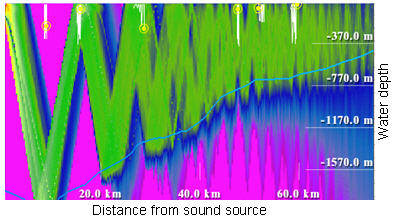[ Lay Language Paper Index | Press Room ]
Kathleen J. Vigness Raposa, kathleen.vigness@marineacoustics.com Marine Acoustics, Inc. Middletown, RI 02842
Adam S. Frankel, Geoff Sisson, William T. Ellison Marine Acoustics, Inc.
Christopher Damon Environmental Data Center, University of Rhode Island
Popular version of paper 4aNS8, “Marine wildlife behavior database for estimating environmental impacts” Presented 11:15 a.m Friday morning, November 30, 2007 154th ASA Meeting, New Orleans, LA
The ocean is full of both natural and human sounds. Much attention has recently been focused on human sounds in the oceans and their potentially harmful effects on marine animals. The impact of sounds on marine animals is affected by a number of factors, including: . the characteristics of the sound, such as its loudness, frequency, and duration; . the situation under which the animals experience the sound; and . the hearing sensitivity, age, sex, and behavior of the animals, characteristics that are unique to individual species. Since animal behavior is an important factor in determining the effects of sound, this project, the Marine Wildlife Behavior Database (http://mwbd.edc.uri.edu), is creating an online database of the diving, movement, and acoustic behaviors of fishes, marine mammals, and sea turtles to aid the scientific community.
Scientists use models to determine how sound affects marine animals. They estimate the level of sound at different distances and depths from the sound source, and then simulate the behavior of animals that might be found in the area. From this, they can determine the sound levels to which the animals might be exposed and estimate the effects these sound levels might have on the animals.
 This picture is an example of the output of such a predictive model, the
Acoustic Integration ModelC (AIM). The background shows how sound moves away
from a source in the upper left hand corner of the image, with the sound
moving from deep to shallow water. The colors show the predicted sound
loudness or intensity at various distances and depths from the sound source,
decreasing from red, orange, and yellow at high levels to green, blue, and
purple at lower levels. The six yellow circles are marine mammals that are
predicted to be in the area while the source is making sound. The white
lines near the yellow circles show the diving and movement patterns of each
of the animals over a period of approximately one hour. These patterns were
created from the same types of data that will be stored within the Marine
Wildlife Behavior Database. By combining the picture of the sound with the
diving and movement patterns of the animals, the amount of sound the animals
might receive can be estimated.
This picture is an example of the output of such a predictive model, the
Acoustic Integration ModelC (AIM). The background shows how sound moves away
from a source in the upper left hand corner of the image, with the sound
moving from deep to shallow water. The colors show the predicted sound
loudness or intensity at various distances and depths from the sound source,
decreasing from red, orange, and yellow at high levels to green, blue, and
purple at lower levels. The six yellow circles are marine mammals that are
predicted to be in the area while the source is making sound. The white
lines near the yellow circles show the diving and movement patterns of each
of the animals over a period of approximately one hour. These patterns were
created from the same types of data that will be stored within the Marine
Wildlife Behavior Database. By combining the picture of the sound with the
diving and movement patterns of the animals, the amount of sound the animals
might receive can be estimated.
As the image shows, the amount of sound that an animal is exposed to depends on their distance from the sound source and their depth in the water. Their range and depth are a function of their behavior; for example, how fast they swim, what depths they dive to, and how long they remain at a given depth. In order to accurately predict the exposure animals will receive, good behavior data are needed.
The Marine Wildlife Behavior Database is creating a worldwide standard for describing marine animal behaviors. Currently, how behavior data are reported depends on the field researcher's preference, the method used for collecting data, and/or the software used for analyzing the data. Because of these differences, behaviors can be described very differently in similar studies. This variability makes it difficult to compare studies and combine all of the available information into one accurate description of the behavior of a species. By working with field researchers and environmental modelers, a consistent format for reporting behavior data is being created that will meet the needs of both scientific communities. The database will be available online (http://mwbd.edc.uri.edu) in the early spring of 2008 so that everyone with an interest in the behavior of marine animals will be able to access the best information available.
[ Lay Language Paper Index | Press Room ]